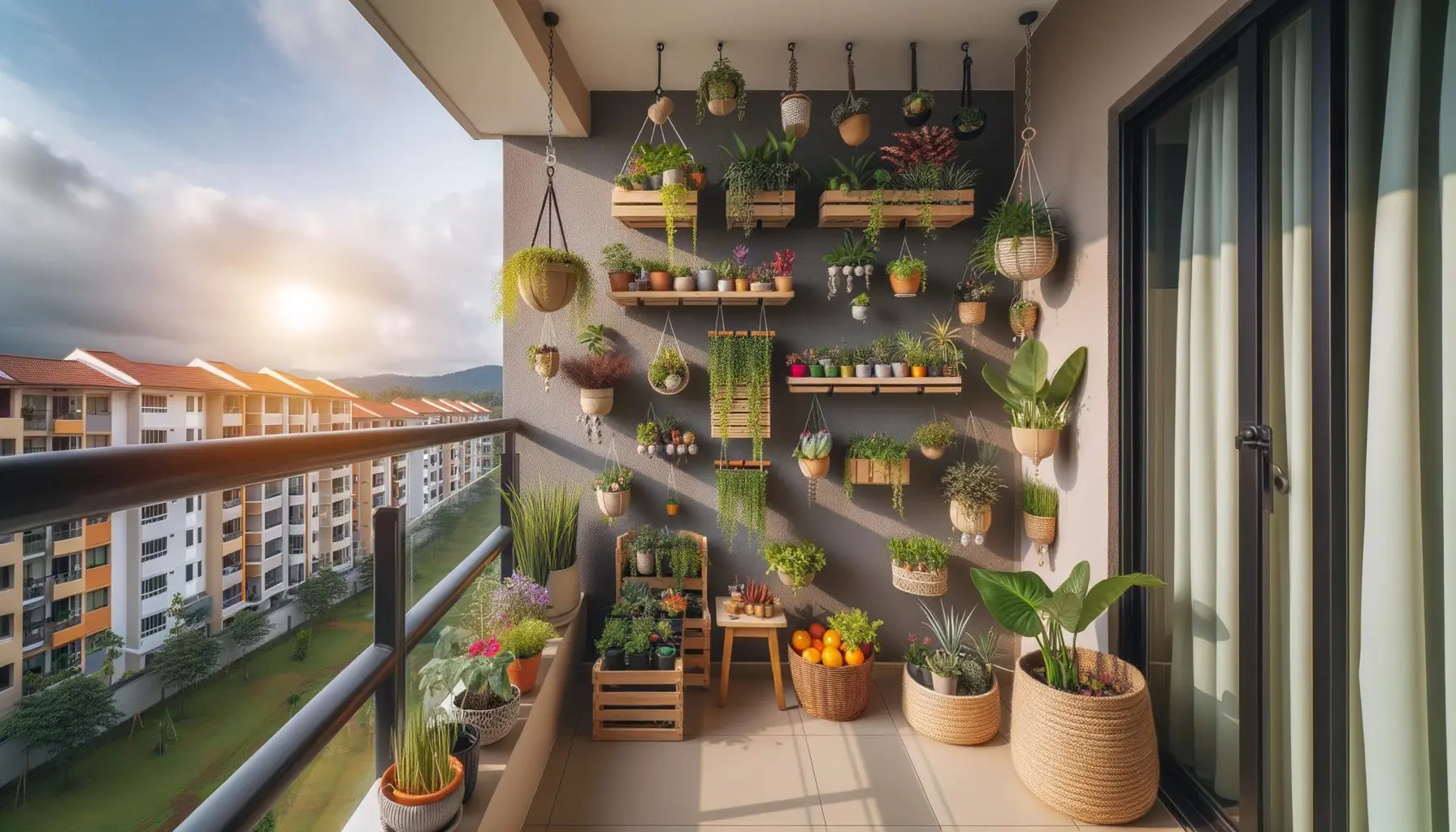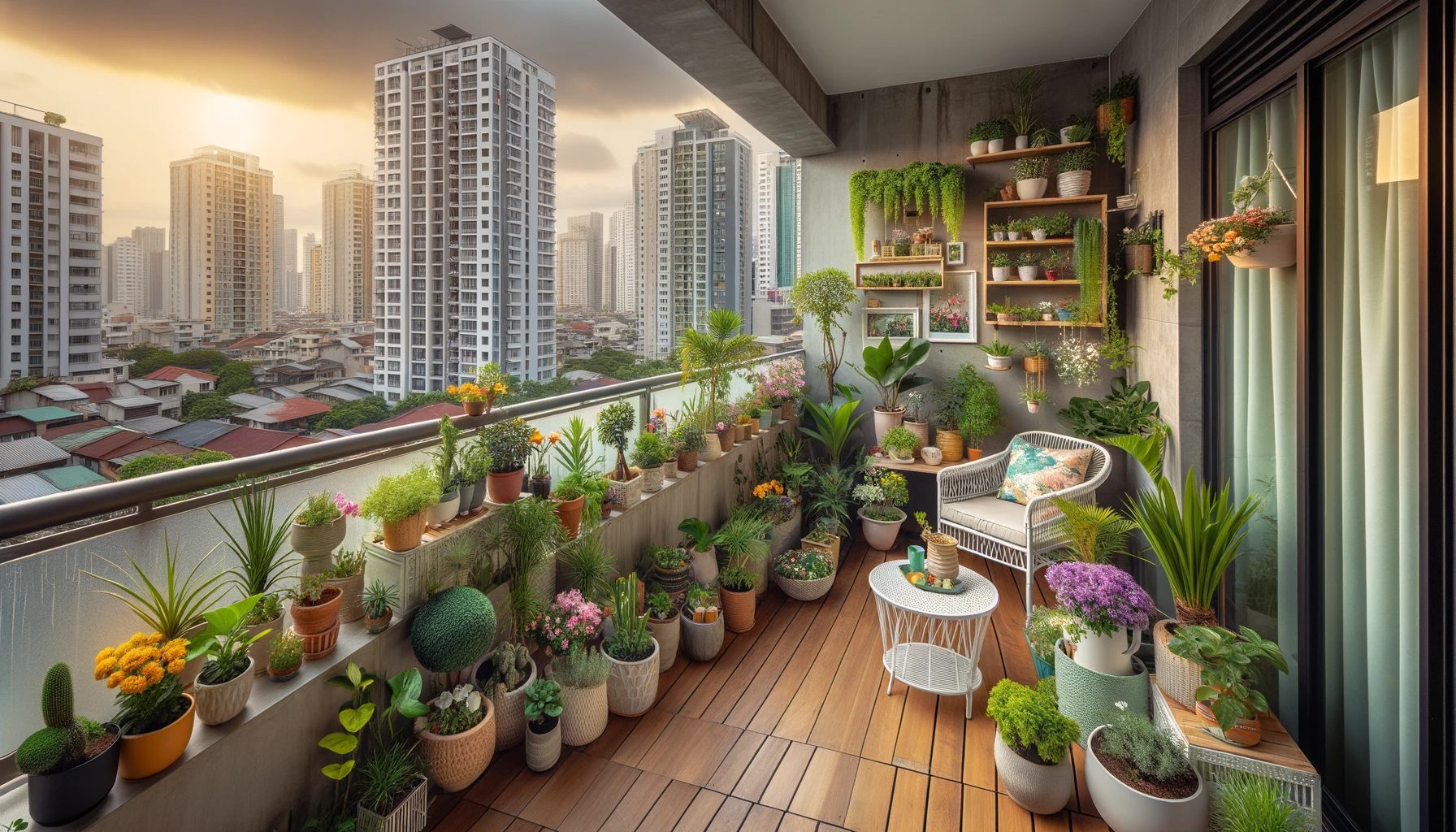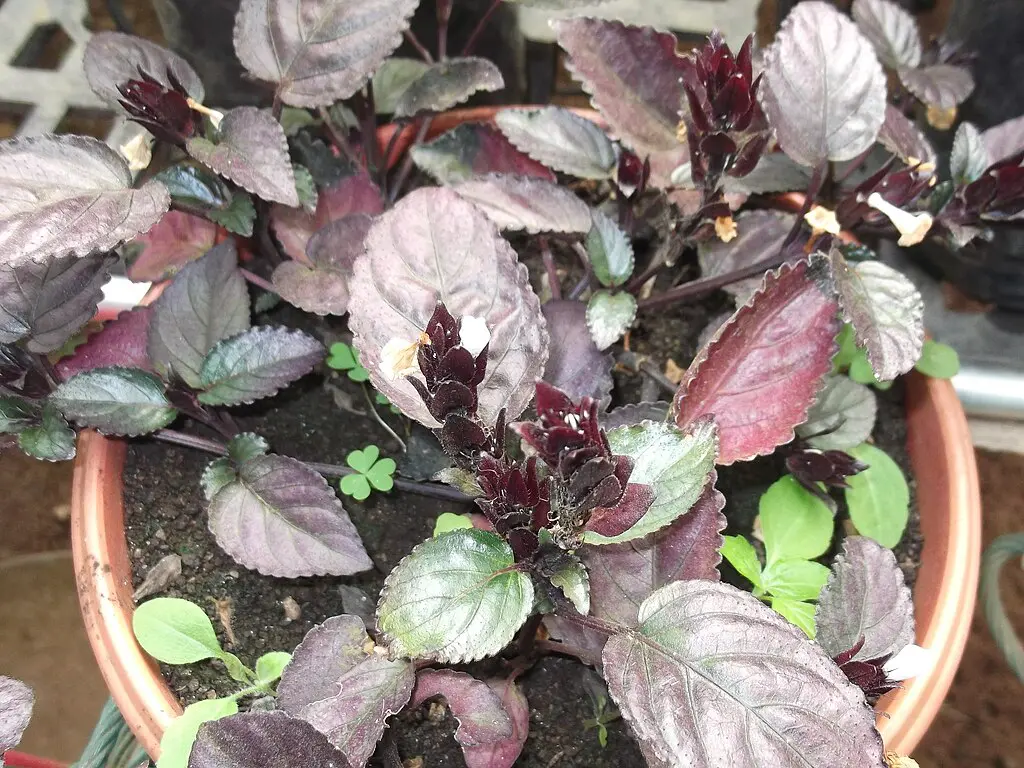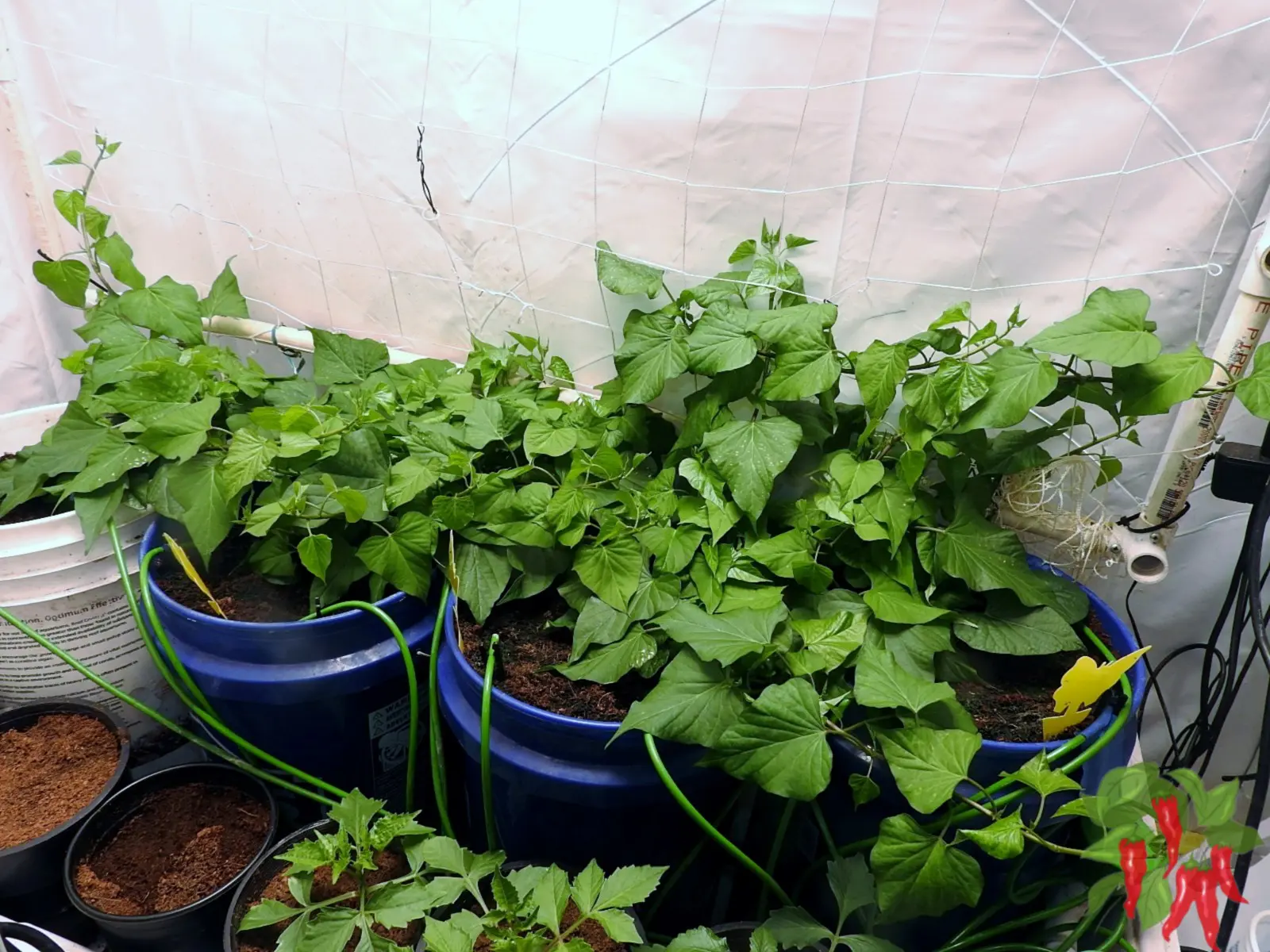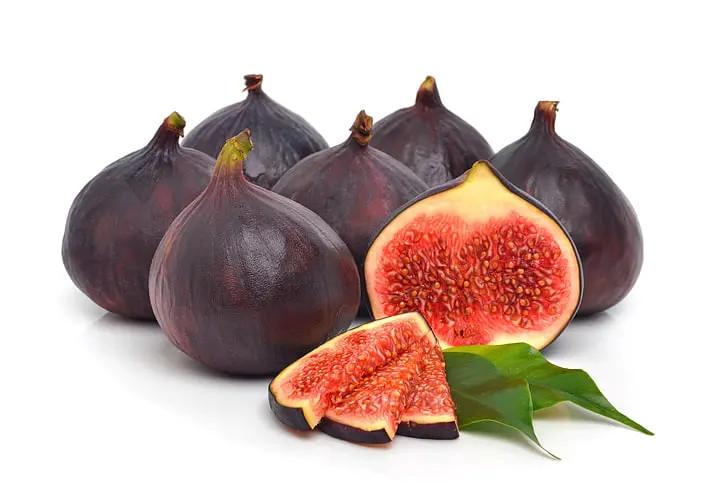This post contains affiliate links. If you buy something from one of our links we may earn a commission. Thanks
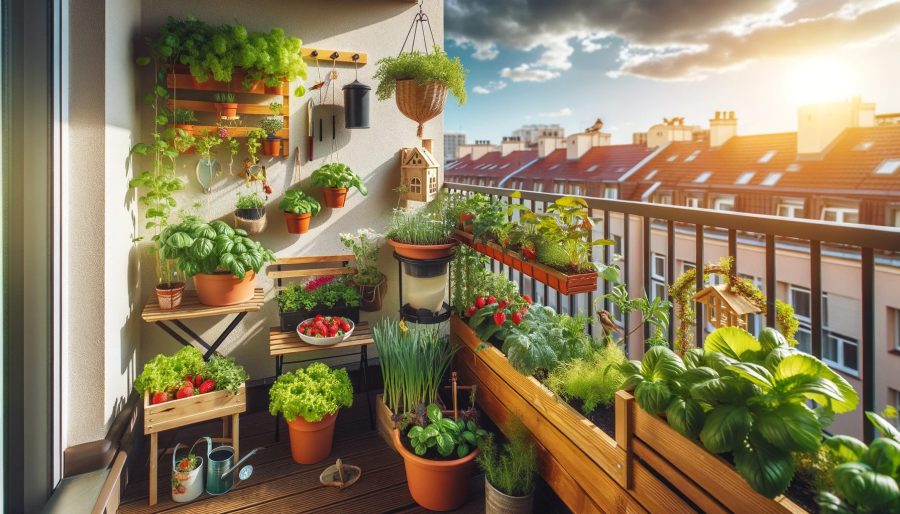
Dive into the green world with our guide on small balcony gardening for beginners. Transform your outdoor space into a lush haven, one pot at a time!
Small Balcony Gardening For Beginners
Key Takeaways:
- Small balcony gardening for beginners involves understanding your space
- Selecting the right containers and soil
- Choosing plants suited to the available sunlight, and regular maintenance.
- With a bit of planning and care, a small balcony can be transformed into a lush, productive garden.
Embarking on the journey of small balcony gardening for beginners is like opening a door to a green oasis.
It’s about turning that tiny outdoor space into a vibrant blend of colors and textures.
The joy of nurturing a plant, watching it grow, and enjoying the fresh air it brings is incomparable.
Our step-by-step guide is here to walk you through every stage of this joyful endeavor, ensuring your small balcony blooms into a beautiful garden.
Small Balcony Gardening for Beginners: A Step-by-Step Guide to Cultivating Your Green Haven

Let’s embark on a gardening journey that transforms a small balcony into a green haven.
It’s about turning limited space into a lush retreat. As city dwellers, we often long for that touch of green in our lives, and what better way to achieve it than by starting a balcony garden?
The joy of seeing the first sprout, the therapeutic touch of soil, and the calmness greenery brings, are unparalleled.
This guide will walk you through every step of creating a beautiful and fruitful garden on your small balcony. Ready to sow the first seed? Let’s dive in!
Understanding Your Space:
Before diving into apartment balcony gardening, it’s essential to understand the space you have.
A small balcony can offer a surprising amount of room for a garden when utilized wisely.
The key factors to consider are the amount of sunlight your balcony receives and how to make the most of your available space.
Balcony Orientation:
Knowing the direction your balcony faces is crucial. It determines the amount of direct sunlight your plants will receive.
A south-facing balcony gets the most sun, while a north-facing one gets the least. The type of plants you can grow depends largely on this factor.
Space Optimization:
The way you organize your plants and containers can significantly impact the amount of space available.
Vertical gardening, utilizing the balcony railing, and hanging planters are great options to maximize space.
Exploring different arrangements helps in creating a garden that is both beautiful and functional.
Choosing the Right Containers:
The foundation of a thriving balcony garden lies in selecting the right containers.
The size, material, and design of the pots are crucial factors that affect the growth and health of your plants.
Self-watering planters can help people with busy schedules keep watering on point.
From large pots for fruit trees to small ones for herbs, each pot serves a unique purpose in your garden.
- Best Pots for Balcony Gardening: Various pots are suitable for balcony gardening. Terracotta pots are excellent for regulating soil moisture but remember they can get quite heavy.
Plastic pots are lighter and retain moisture well. The right pot caters to the specific needs of your plants and enhances the overall aesthetics of your balcony garden.
- Drainage Essentials: Proper drainage is vital to prevent waterlogging, which could lead to root rot. Ensure your pots have adequate drainage holes.
Placing a layer of pebbles or broken terracotta pieces at the bottom of the pot can aid in better drainage.
- Elevating Your Pots: Elevating pots ensures better drainage and prevents water stains on your balcony floor.
It also makes it easier to move the pots around when needed. Various stands, racks, or even rolled-up towels can serve the purpose.
Container Gardening
Containers are a great option if gardening space is limited, soil conditions are poor, or if you simply want more control over growing conditions. Growing food in adequately sized containers is easy and offers some advantages over growing in the ground. Many gardeners with plenty of garden space still grow certain things in containers. From WSU Cooperative Extension
Soil and Mulching:
The soil is the lifeline of your garden. It’s not just about filling pots; it’s about creating a nurturing environment for your plants.
Along with soil, mulching plays a pivotal role in retaining soil moisture and keeping your plants healthy.
Let’s unearth the basics of soil and mulching for your balcony garden.
Soil Selection:
Choosing the right soil is crucial for your balcony garden. Bagged topsoil can be a good starting point, but adding some organic compost will provide your plants with the nutrients they need.
A mix of coco coir and 25% perlite provides excellent drainage and good moisture retention. It also is an environmentally friendly and sustainable option.
Also, consider the type of plants you have; succulents and cacti prefer sandy soil, while most vegetables and flowers thrive in loamy soil.
Mulching Techniques:
Mulching is a great idea to retain soil moisture and keep weeds at bay.
The best mulch for your balcony pots could be organic materials like straw, leaves, or small bark chips.
Mulch also adds a finished look to your pots, making your balcony garden more appealing.
Selecting Plants:
Now comes the exciting part, selecting plants for your garden. Whether you have a sunny balcony or a shady one, choosing the right plants is essential for a thriving garden.
From low-maintenance plants to seasonal vegetables, the options are abundant.
- Low-Maintenance Balcony Plants: For those with a busy schedule, low-maintenance plants are a great choice.
- Consider succulents, snake plants, or spider plants that require minimal care. These plants are not only easy to care for but also add a modern touch to your balcony garden.
- Vegetable Gardening: Growing your own veggies is a rewarding experience. Start with easy-to-grow vegetables like cherry tomatoes, lettuce, and radishes.
- If you have a sunny balcony, peppers and cucumbers are also great options. Remember, the right pot and good-quality soil are crucial for a bountiful vegetable garden.
Designing Your Balcony Garden:
Designing your balcony garden is where creativity meets functionality.
It’s about making the most of the available space while creating an aesthetically pleasing outdoor space.
From arranging pots to adding some garden decor, designing your garden is an evolving and enjoyable process.
• Balcony Garden Design Principles: Implementing basic design principles can transform your tiny balcony into a green oasis.
• Use vertical space wisely with shelves, railing planters, and hanging pots. Mix and match different types of plants and pots to create visual interest.
• Apartment Balcony Gardening Ideas: Get creative with your space. Add a small table and chairs to enjoy your morning coffee amidst greenery.
Incorporate some garden lights for a cozy evening ambiance. The idea is to create a space where you would love to spend time.
These sections delve into the soil, plant selection, and design aspects of balcony gardening, setting a strong foundation for a green retreat right in your urban dwelling.
The next part will cover maintaining your balcony garden, troubleshooting common issues, and expanding your knowledge.
Maintaining Your Balcony Garden:
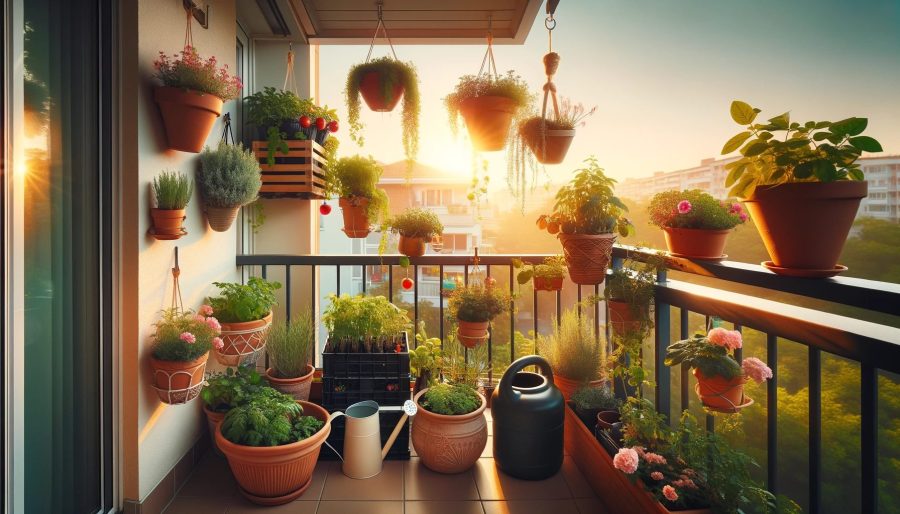
A flourishing balcony garden is a delightful sight in any apartment building.
The transition from a barren balcony space to a green oasis is not only a great way to utilize the small space but also a step towards urban gardening.
Maintenance, although initially seeming like much work, soon becomes a pleasant routine that not only connects you to nature but also brings a slice of peace amidst the urban chaos.
The charm of a well-maintained garden is unmatched and becomes a perfect spot for a cup of coffee or a calm evening read.
Routine Care:
- Watering: Regular watering is crucial for plant life. The amount of water plants need depends on the weather conditions, the type of plants, and the amount of sunlight they receive.
- Investing in a good quality watering system is a good idea, especially during the warmer seasons when plants may need more water.
- It’s better to water deeply and less frequently to encourage root growth. Also, early morning or late afternoon is the perfect time for watering to prevent evaporation.
- Pruning: Timely pruning not only keeps your plants looking neat but also encourages new growth.
- Dead leaves or old flowers should be removed to make way for new buds. Pruning also helps in identifying any pests or diseases early on.
- Sunlight: Monitoring the hours of sun your balcony receives helps in understanding the growing conditions of your balcony garden.
- Plants labeled as full sun need at least 6 to 8 hours of sunlight, while those requiring partial shade do well with less.
- Rearranging your plants to ensure they receive the required sunlight helps in keeping them healthy.
- Pest and Disease Control: A regular check for pests and diseases is crucial for maintaining a healthy garden. Identifying and addressing these issues early on saves much time and effort in the long run.
- Fertilizing: Plants in pots need more fertilizing than those in the ground. A balanced fertilizer applied during the growing season keeps your garden plants healthy and vibrant.
- Seasonal Care: Each season brings different challenges and requirements. For instance, protecting your plants from much heat in summer and cold in winter is essential.
- Transitioning your garden plants according to the seasons keeps the garden lively year-round.
- Exploring New Plants: Every season could be a chance to try growing new plants.
- From sun-loving plants in summer to seasonal blooms in spring, exploring different plants adds a new dimension to your garden.
- Gardening Tools: Having the right gardening tools makes maintenance much easier.
- Basic tools like pruners, a watering can, and gloves are essential for every gardener.
- Learning and Evolving: The only thing constant in gardening is learning. Each day brings a new lesson, be it in the form of a thriving plant or a lesson from a plant that didn’t make it.
- Embrace the learning curve, and you’ll see your green space evolving beautifully over time.
Conclusion: Maintaining your balcony garden is a blend of routine care, understanding your plants, and evolving with experience. It’s about celebrating the green life amidst concrete, one leaf at a time.
Troubleshooting Common Issues:
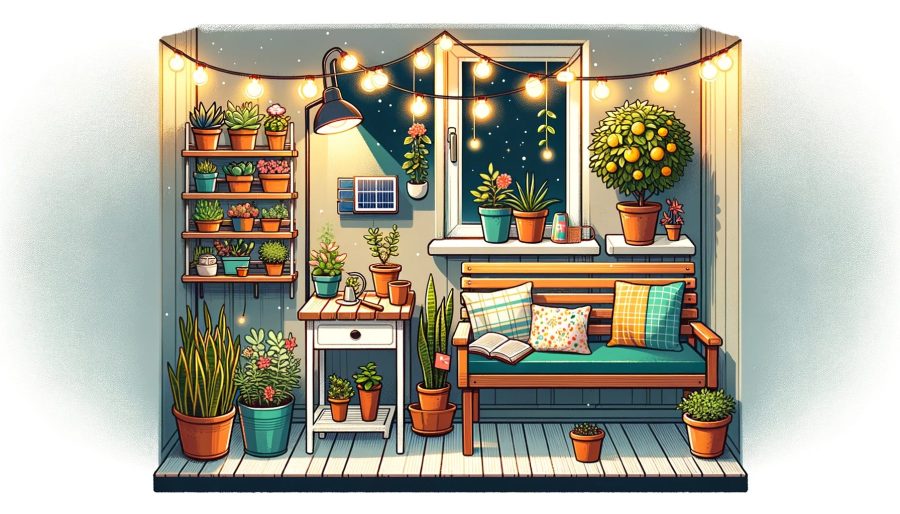
Every gardener, whether seasoned or a newbie, faces challenges. But with a bit of knowledge and the right approach, these can be easily overcome.
From insufficient sunlight to pest infestations, we’ll cover common issues and their solutions.
Balcony gardening, especially in an apartment building, comes with a unique set of challenges that, when addressed timely, pave the way for a thriving garden.
Balcony Gardening Tips for Beginners:
- Identifying and Addressing Pests: Common pests like aphids, spider mites, and whiteflies could visit your garden. Early detection and natural remedies like neem oil or insecticidal soap can be effective. Encouraging beneficial insects like ladybugs also helps in natural pest control.
- Water Management: Over-watering is a common issue. Ensure your pots have drainage holes to let out excess water. Understanding the watering needs of each plant and adjusting your watering routine, especially during rainy seasons, helps in maintaining moist soil without waterlogging.
- Soil Quality: Poor soil can be amended with the addition of organic compost or well-rotted manure. If your plants aren’t thriving, checking the soil pH and nutrient levels is a good idea. A visit to a local garden center could provide you with the necessary amendments and advice.
- Sunlight Issues: Insufficient or too much sunlight can affect plant growth. Observing your plants and moving them to different spots to receive the right amount of sunlight is essential. Shade cloths or umbrellas can be used to protect plants from harsh afternoon sun.
- Plant Nutrition: Yellowing leaves or stunted growth often indicate a lack of nutrients. A balanced fertilizer, applied as per instructions, can provide the necessary nutrients and boost plant growth.
- Seasonal Challenges: Every season brings new challenges. Being prepared for frost in late spring or the intense heat in summer is essential. Seasonal care, like moving sensitive plants indoors during frost or providing plenty of water during summer, ensures your garden stays vibrant year-round.
- Space Management: Balcony garden ideas often revolve around making the most of the available space. Vertical gardening, using window boxes, and hanging planters are great ways to maximize space. Experimenting with different arrangements helps in finding what works best for your balcony garden.
- Plant Selection: Choosing the right plants for your balcony conditions is crucial. Selecting sun-loving plants for sunny balconies and shade-tolerant plants for less sunny spots makes a significant difference in how your garden thrives.
Troubleshooting common issues is part and parcel of the gardening journey. As you spend more time with your plants, understanding their needs and responding to their cues becomes second nature.
Each challenge overcome is a step towards becoming a more knowledgeable and confident balcony gardener.
Expanding Your Knowledge:
Expanding knowledge is the cornerstone of mastering any hobby, particularly one as hands-on and rewarding as gardening
The voyage of discovery in gardening never ends. As you nurture your balcony garden, you’ll uncover a hobby that grows with you, offering endless opportunities for learning and enjoyment.
Even if your balcony garden started as a small project, it might spark a lifelong passion for greenery and open doors to a larger world of gardening knowledge.
Whether you have a tiny balcony or a more spacious outdoor patio or terrace, the learnings from your balcony garden will always find relevance.
Further Resources:
- Books: There’s a vast array of books dedicated to gardening. From understanding the basics to exploring advanced techniques, books are a treasure trove of knowledge. Some focus on urban gardening, others on specific types of plants like succulents, orchids, or edible plants.
- Books like The Balcony Gardener by Isabelle Palmer or Container Gardening Complete by Jessica Walliser are great options to delve deeper.
Online Courses and Blogs:
Numerous online platforms offer courses on gardening. Platforms like Udemy or Coursera provide structured learning experiences.
Additionally, following blogs or YouTube channels dedicated to balcony gardening or urban gardening can provide new insights and introduce you to a community of like-minded garden enthusiasts.
Local Workshops and Garden Centers:
Local workshops are a fantastic way to get hands-on experience and direct feedback.
Garden centers often hold workshops or have experts available for advice.
They are also great places to discover new plants, gardening tools, and organic fertilizers and pesticides.
Community Engagement:
Engaging with a community of balcony gardeners, whether online or locally, allows you to share experiences, learn from others, and even swap plants or seeds. Platforms like Reddit or local gardening clubs are good places to start.
Garden Visits and Tours:
Visiting well-maintained gardens, and botanical gardens, or going on garden tours can provide inspiration and practical ideas that can be replicated in your balcony garden.
Experimentation:
Don’t hesitate to try new things in your garden. Whether it’s experimenting with different types of plants, trying new planting techniques like vertical gardening, or testing different soil amendments, every experiment is a learning opportunity.
Keeping a Garden Journal:
Documenting your gardening journey, noting down what works and what doesn’t, and keeping a record of plant growth, challenges, and successes is a great way to learn from your experiences.
Expanding your knowledge is a continuous and rewarding part of balcony gardening.
As you learn, experiment, and engage with the gardening community, you’ll find your balcony garden flourishing and reflecting the enriched gardener in you.
The sky’s the limit when it comes to learning in gardening, and every day brings a new lesson, a new success, or a valuable lesson from a challenge faced.
Conclusion: Embarking on a balcony gardening journey is a step towards self-sufficiency, a leap towards sustainability, and a stride towards mental peace.
Your small balcony is a canvas waiting for your green touch. As you sow, so shall you reap.
The rewards of balcony gardening extend far beyond the balcony edge, adding fresh breaths of greenery to urban living.
Balcony Gardening for Beginners FAQs
Embarking on a balcony gardening journey comes with its fair share of questions. It’s a new experience filled with curiosity, learning, and a bit of trial and error.
We’ve gathered some frequently asked questions to provide you with quick, straightforward answers to help you on your gardening journey.
Q: How do you organize plants in a small balcony?
A: Utilizing vertical space with shelving units, hanging pots, and railing planters are an excellent way to organize plants. Arranging pots in a tiered manner also maximizes space and sunlight exposure for each plant.
Q: What are the best pots for balcony gardening?
A: Terracotta pots, ceramic pots, and self-watering pots are some of the best options. Each has its unique benefits, like good drainage, moisture retention, or ease of maintenance.
Q: What veggies can I grow on my balcony?
A: Cherry tomatoes, lettuce, radishes, peppers, and cucumbers are some easy-to-grow veggies. The key is to choose dwarf or container-friendly varieties and ensure they receive the right amount of sunlight.
Q: What kind of soil do you use for a balcony garden?
A: A mix of good-quality potting soil and organic compost works well for most balcony gardens. Ensure the soil is well-draining to prevent waterlogging.
Q: How do I turn my balcony into a garden?
A: Start by assessing your space, choosing the right containers, selecting suitable plants, and arranging them efficiently. Adding some garden decor and seating can also enhance the garden feel.
Q: Can I use bagged topsoil for potted plants?
A: Yes, but it’s advisable to mix it with organic compost or potting soil to provide the necessary nutrients and improve drainage.
Q: What is the best mulch for balcony pots?
A: Organic mulches like straw, leaves, or small bark chips are excellent choices. They help retain soil moisture, control weeds, and improve soil quality.
Q: What do you put in the bottom of a planter for drainage?
A: Placing a layer of pebbles, broken terracotta pieces, or a piece of mesh screen can aid in better drainage.
Q: Should I put mulch on top of my potted plants?
A: Yes, mulching helps retain moisture, suppress weeds, and improve soil quality.
Q: What are easy vegetables to grow in pots?
A: Leafy greens, radishes, cherry tomatoes, and peppers are some easy vegetables to grow in pots.
Q: How do you grow cucumbers on a balcony?
A: Use a large pot, ensure plenty of sunlight, and provide a trellis for support as cucumbers grow vertically.
Q: How do you arrange pots on a balcony?
A: Arrange pots based on plant height, sunlight requirements, and ease of maintenance. Utilizing corner spaces and wall-mounted shelves can also be beneficial.
Q: Do outdoor pots need saucers?
A: Saucers help catch excess water, prevent floor stains, and maintain moisture. However, ensure they don’t cause waterlogging.
Q: How do I get the most out of my balcony?
A: Maximize space, choose the right plants, ensure proper care, and create a pleasant ambiance with seating and decor.
Q: What can I use to elevate my pots?
A: Pot stands, bricks, or even upturned smaller pots can be used to elevate pots for better drainage and ease of maintenance.
With these FAQs, we aim to cover the common queries that balcony garden beginners might have.
Each question takes you one step closer to mastering the art of balcony gardening and enjoying a lush, green space in your urban dwelling.
Conclusion: A Green Respite in Urban Living
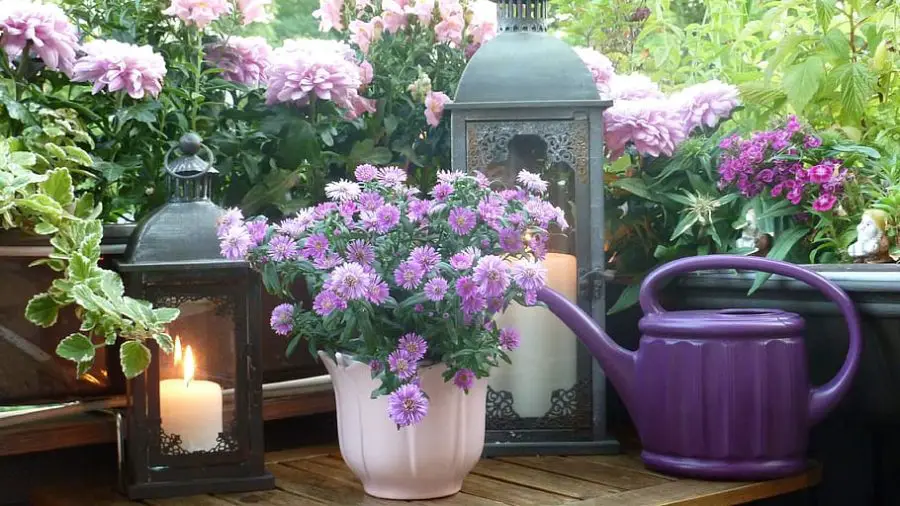
The Beginning of a Green Journey: Embarking on a balcony gardening journey is more than just a casual venture; it’s a step towards self-sufficiency, a leap towards sustainability, and a stride towards mental peace.
Your small balcony is a canvas waiting for your green touch. It’s a microcosm of nature that awaits your creativity and care.
As you sow, so shall you reap. Each seed planted, and each bud bloomed takes you a step closer to a living, breathing garden that reflects your love, care, and commitment.
Beyond the Balcony Edge: The rewards of balcony gardening extend far beyond the balcony edge.
It’s not just about the fresh tomatoes plucked right from your balcony or the aroma of fresh herbs wafting through your home; it’s about the inherent satisfaction and joy derived from nurturing life.
Balcony gardening transforms your outdoor space into a sanctuary where life burgeons in every nook and cranny, adding fresh breaths of greenery to urban living.
Growing More Than Just Plants: With every watering, pruning, and harvesting, you not only grow plants but also cultivate patience, mindfulness, and a deep appreciation for nature’s pace in a world that’s constantly rushing.
Your balcony garden becomes a living testament to the natural cycles of growth, a reminder of the beauty and resilience of life, and a personal retreat where you can unwind, reflect, and rejuvenate.
Inspiring Green Communities: The ripple effect of your gardening endeavor touches not only your life but also those around you.
It inspires others to embrace gardening, fosters a community of nature enthusiasts, and contributes to a greener, healthier urban environment.
The chirping birds that visit, the butterflies that flutter by, and even the curious neighbors who stop to admire your garden touch lives in ways unimaginable.
A Lifelong Learning Experience: Moreover, the knowledge acquired, the skills honed, and the connections forged with fellow gardeners contribute to a rich, lifelong learning experience.
The challenges faced, the solutions discovered, and the success celebrated are all threads in the beautiful tapestry of your gardening journey.
The Realm of Endless Possibilities: As your plants reach toward the sky, so does your understanding and appreciation of nature’s simple yet profound lessons.
The balcony garden, no matter how small, is a realm of endless possibilities, learning, and joy.
So, as you step into this green realm, know that you’re nurturing not just a garden, but a space of serenity, learning, and growth.
Your little balcony garden is a world in itself, ready to bloom with each tender care you provide.








